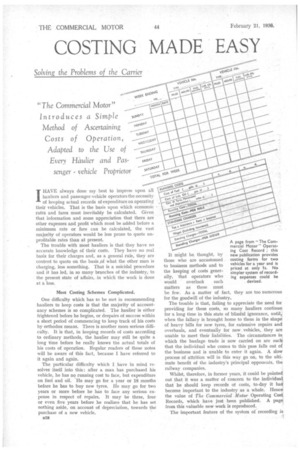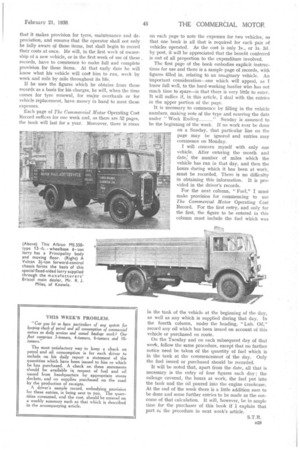COSTING MADE EASY
Page 42

Page 43

If you've noticed an error in this article please click here to report it so we can fix it.
Solving the Problems of the Carrier
"The Commercial Motor" introduces a Simple
Method of Ascertaining !wpm:0 Costs of Operation, to the Use of Every Haulier and Pas .n. senger vehicle Proprietor IHAVE always always done my best to impress upon all hauliers and passenger-vehicle operators the necessity of keeping actual records of expenditure on operating their vehicles. That is the basis upon which economic rates and tares must inevitably be calculated. Given that information and some appreciation that there are other expenses and profit which must be added before a minimum rate or fare can be calculated, the vast majority of operators would be less prone to quote unprofitable rates than at present.
The trouble with most hauliers is that they have no accurate knowledge of their costs. They have no real basis for their charges and, as a general rule, they are content to quote on the basis of what the other man is charging, less something. That is a suicidal procedure and it has led, in so many branches of the industry; to the present state of affairs, in which the work is done at a loss.
Most Costing Schemes Complicated.
One difficulty which has to be met in recommending hauliers to keep costs is that the majority of accountancy schemes is so complicated. The haulier is either frightened before he begins, or despairs of success within a short period of commencing to keep track of his costs by orthodox means. There is another more serious difficulty. It is that, in keeping records of costs according to ordinary methods, the haulier may still be quite a long time before be really knows the actual totals of his costs of operation. Regular readers of these notes will be aware of this fact, because I have referred to it again and again.
The particular difficulty which I have in mind resolves itself into this : after a man has purchased his vehicle, he has no running cost to face, but expenditure on fuel and oil. He may go for a year or 18 months before he has to buy new tyres. He may go for two years or more before he has to face any serious expense in respect of repairs. It may be three, four or even five years before he realizes that he has set nothing aside, on account of depreciation, towards the purchase of a new vehicle.
az8 It might be thought, by those who are accustomed to business methods and to the keeping of costs generally, that operators who would overlook such matters as these must be few. As a matter of fact, they are too numerous for the goodwill of the industry,
The trouble is that, failing to appreciate the need for providing for these costs, so many hauliers continuo. for a long time in this state of blissful ignorance, until,. when the fallacy is brought home to them in the shape of heavy bills for new tyres, for extensive repairs and overhauls, and eventually for new vehicles, they are unable to meet their liabilities. The circumstances in which the haulage trade is now carried on are such that the individual who comes to this pass falls out of the business and is unable to enter it again. A slow process of attrition will in this way go on, to the ultimate benefit of the industry's principal opponents, the railway companies.
Whilst, therefore, in former years, it could be pointed out that it was a matter of concern to the individual that he should keep records of costs, to-day it haS become important to the industry as a whole. Hence the value of The Commercial Motor Operating Cost Records, which have just been published. A page from this valuable new work is reproduced.
The important feature of the system of recording is
A page from "The Commercial Motor" Operating Cost Record ; this new publication provides costing forms for two vehicles for a year and is priced at only is. No simpler system of recording expenses could be
devised.
that it makes provision for tyres, maintenance and depreciation, and ensures that the operator shall not only be fully aware of those items, but shall begin to record their costs at once. He will, in the first week of ownership of a new vehicle, or in the first week of use of these records, have to commence to make full and complete provision for these items. At that early date he will know what his vehicle will cost him to run, week by week and mile by mile throughout its life.
If he uses the figures which he obtains from these records as a basis for his charges, he will, when the time comes for tyre renewal, for major overhauls or for vehicle replacement, have money in hand to meet those expenses.
Each page of The Commercial Motor Operating Cost Record suffices for one week and, as there are 52 pages, the book will last for a year. Moreover, there is room on each page to note the expenses for two vehicles, so that one book is all that is required for each pair of vehicles operated. As the cost is only is., or Is. 3d. by post, it will be appreciated that the benefit conferred is out of all proportion to the expenditure involved.
The first page of the book embodies explicit instructions for use and there is a sample page of records, with figures filled in, relating to an imaginary vehicle. An important consideration—one which, will appeal, as I know full well, to the hard-working haulier who has not much time to spare—is that there is very little to enter. It will suffice if, in this article, I deal with the entries in the nipper portion of the page.
It is necessary to commence by filling in the vehicle numbers, making note of the type and entering the date under "Week Ending " Sunday is assumed to be the beginning of the week If no work ever be done on a Sunday, that particular line on the page may be ignored and entries may commence on Monday.
I will concern myself with only one vehicle. After entering the month and date; the number of miles which the vehiCle has run in that day, and then the hours during which it has been at work, must be recorded. There is no difficulty in obtaining this information. It is provided in the driver's records. • For the next column, "Fuel," I must make provision for commencing to use The Commercial Motor Operating Cost Record. For the first entry,. and only for the first, the figure to be entered in this column must include the fuel which was in the tank of the vehicle at the beginning of the day, as well as any which is supplied during that day. In the fourth column, under the heading, "Lub. Oil," record any oil which has been issued on account of this vehicle or purchased en route.
On the Tuesday and on each subsequent day of that week, follow the same procedure, except that no further notice need be taken of the quantity of fuel which is in the tank at the commencement of the day. Only the fuel issued or purchased should be recorded.
It will be noted that, apart from the date, all that is necessary is the entry of four figures each day; the mileage covered, the hours at work, the fuel put into the tank and the oil poured into the engine crankcase. At the end of the week there is a little addition sum to be done and some further entries to be made as the outcome of that calculation. It will, however, be in ample time for the purchaser of this book if I explain that part aL the procedure in next week's article.




























































































